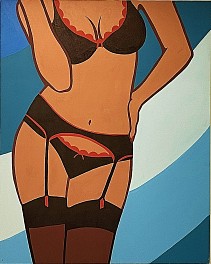BIOGRAPHY

American, 1931-2014
As a female artist in a field dominated by men, Strider tackled a subject--the pinup girl--that was synonymous with the objectification of women. The New York Times called her "a Pop artist who slyly subverted her male counterparts' takes on consumerism and the female form. . . " She was one of few female artists to work in the genre, other examples being Rosalyn Drexler and Marisol. Her work can be found in the collections of the Guggenheim, the Hirshorn, the Albright-Knox, the Newark Museum and others.
Strider was a key member of the 60s avante-garde. She was included in the "The First International Girlie Show" at the Pace Gallery in 1964, along with several soon-to-be stars of the movement, including Andy Warhol, Roy Lichtenstein and Tom Wesselman. With the introduction of Hugh Hefner’s Playboy magazine in 1954 the pin-up, now rendered as the “centerfold,” increased in social acceptance and exposure. By the early 1960s, the subject fit perfectly with the other types of imagery adopted by Pop artists: brand-name products, consumer items, signs of quintessentially American modern life. Also “associated with the good life in America,” the all-American girl, and the male fantasies that gave rise to her, emerged as one aspect of the American dream.
As a female artist among a movement dominated by men, it was always surprising that Marjorie Strider tackled an unlikely subject of the pin-up girl, a theme that was virtually synonymous with the objectification of women. However, Strider’s work was a study in contradictions as she used pictures of pin-ups in order to overcome what the very pin-ups were causing in the first place. It is this skillful contradiction that generates the humor and pleasure we derive from Marjorie Strider’s art and is what marks its historical importance.
